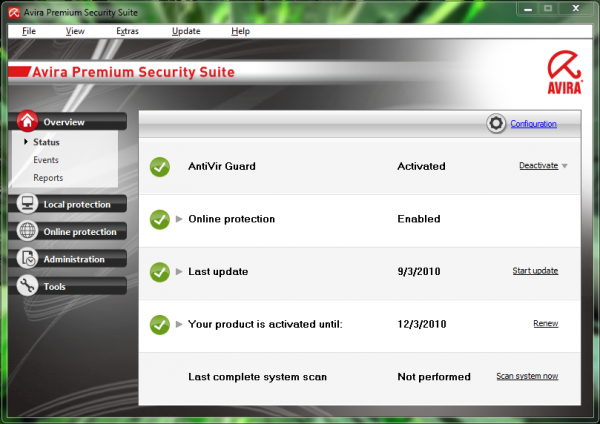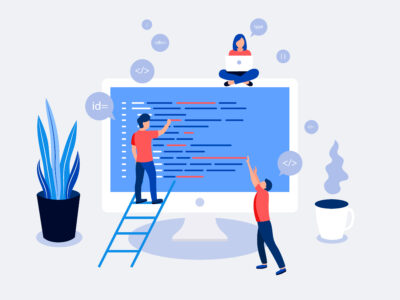
A lot of security companies have been putting their suites through intense user interface makeovers lately, in the attempt to assure larger shares of the user security market. McAfee’s Total Protection 2010, retailing at $79.99, is a total deviation from any of its predecessors, and CA drafted the wizard of design at Frog Design to produce the complicated new 3 dimensional interface for the CA Internet Security Suite Plus 2010, retailing at $69.00. Deviating from this theme, the Avira Premium Security Suite 10, although it has different coloring and icons from the previous edition, retains an almost unchanged general layout. Regrettably, although there are some advances to the underlying suite, not enough has changed in this area either.
It retains its busy interface, with a large amount of activity on its main screen. Controls which run down the side of the screen select both the action and status panels for the different elements, and an almost redundant menu copies these choices, although its additions include rescue CD download; current malware signatures; and the boot record scan.
These settings all appear in a distinct configuration window compile of 2 modes, expert, and regular. The expert settings are understandable for the most part, although there are a few strange options: you apparently need to be an expert user to exchange the PC speaker notification for a WAV file.
Installation went smoother than the Avira AntiVir Personal 10 did, and with help from the Rescue CD it was easily installed on all 12 of test systems that were infected with malware. Problems occurred, however, with 1 suite not being able to update on 1 system, and another not running at all. Although the tech support did solve both these problems, a good amount of emailing back and forth had to occur, with requests for logs and data from each system necessary to do this.
After Avira installation was completed on the testy system that was clean, preparation was done for testing its performance, and the results were not good. A section of the test is clocking the length of time necessary in order to download an index of 100 websites fully, and, because 1 of these sites served up a envenomed third party advertisement the unreliable XP Defender Pro was installed onto the system: Avira did not prevent this, nor did its scan even pick up that this was a problem.
XP Defender Pro was insistent with its demands for proof of paid registration in order to remove the supposed threats to the system found by its counterfeit scans, and it also repeatedly showed a fake Security Center window advising registration. When an online search was made as to instructions for manual removal, a page suggesting registry for XP Defender Pro appeared instead. It being a weekend, and tech support not available until the Monday following, a clean system had to be used in order to locate these instructions so as to handle the issue. Not a very good introduction to the suite’s protection abilities.
AV-Comparatives.org has subjected Avira’s technology to a rigorous amount of testing, and its score overall was quite high. The top rating was graded as ADVANCED+ for both the on demand test based on signatures as well as the more proactive non signature test, although it did supply multiple false positives. Dynamic protections tests evaluating entire suites in real world situations, it scored ADVANCED, and the only suites scoring the higher ADVANCED+ were the Norton Internet Security 2010, retailing at $69.99, and the Kaspersky Internet Security 2010, which retails at $79.99.
Avira was certified for detecting, but not cleaning, by the ICSA Labs, and it has not been tested by the West Coast Labs. In 4 of the 10 tests based on Windows provided by Virus Bulletin, it did not gain the VB 100 percent rating, and, although the labs’ test results were adequate, the competing products manage much higher scores.
In the majority of cases, vendors’ complete full suite and anti malware provide exact protection in terms of the clearing of malware and the deflection of any more infestation. Because of this suite offering protecting elements separately from the free AntiVir Personal package, however, tests made up of the full anti malware testing regimen were run. These results were almost identical: although the premium version did clear some threats better than the free version, the free version provided extra help. Avira’s forums, which are the only recourse for help for the free version, provide the advice necessary to troubleshoot installation problems encountered while making use of Malwarebytes’ Anti Malware and the Hijack This service from Trend Micro. These third party instruments advance the free version in certain areas, namely rootkit removal.
Similarly to the free version, Avira suite’s scans first checks for rootkits, and then for malware that is active in the memory. You need to grant permission for it to remove active malware, and it occasionally requests both rescans and reboots. Also, if you are using a trial version, you will need to remove a message that appears before the scan will complete. It took around half an hour to complete the scan on the test system that was clean, an average time, at best. You cannot leave it to do so unattended however, since responses are needed to the prompts it provides.
Avira managed to score 7 out of 10 for the removal of malware, and, although this total is slightly higher than AntiVir personal’s 6.5, and the same as those assigned to Microsoft Security Essential 1.0 and McAfee Total Protection 2010, it was outdone by others. Norton Antivirus 2010 managed 8, and PC Tools Internet Security 2010, retailing at $49.95, beat them all with a score of 8.3.
Avira achieved a very low score from testing commercial keyloggers instead of actual malware, 3.5, the same score that AntiVir Personal attained. This low score is not the result of a company determination to exclude these from detection: all keyloggers but 1 were found to be malware, but there were problems with their removal. Executable files were left behind by keyloggers identified as malware, and more than half were left running. Although this is not a definitive test, it’s still a very poor score.
At a total of 4.1, the Avira suite scored slightly behind the free edition in testing against rootkits from both keylogger collections and malware, simply as a result of the third party help available with the free edition. Although it did discover each one of the rootkits samples, Avira not only left the majority of these running, and, some with their technology test. In contrast, a score of 4.8 for the removal of scareware, or rogue security software, was higher than the 3.5 scored by the free version, although 4.8 is still well below average.










Comments